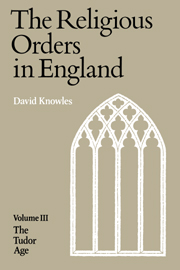Book contents
- Frontmatter
- Contents
- Preface
- List of Abbreviations
- Part One The Tudor Scene
- Part Two The Gathering Storm
- Part Three Suppression and Dissolution
- Part Four Reaction and Survival
- Appendix I Sir Thomas More's letter ‘to a monk’
- Appendix II Religious houses suppressed by Cardinal Wolsey
- Appendix III The witness of the Carthusians
- Appendix IV Houses with incomes exceeding £1000 in the Valor Ecclesiasticus
- Appendix V The sacrist of Beauvale
- Appendix VI Itinerary of the visitors, 1535–6
- Appendix VII The commissioners for the survey of the Lesser Houses in 1536
- Appendix VIII The conflict of evidence on the monasteries
- Appendix IX The last abbots of Colchester, Reading and Glastonbury
- Appendix X Regulars as bishops
- Bibliography
- Index
- Frontmatter
- Contents
- Preface
- List of Abbreviations
- Part One The Tudor Scene
- Part Two The Gathering Storm
- Part Three Suppression and Dissolution
- Part Four Reaction and Survival
- Appendix I Sir Thomas More's letter ‘to a monk’
- Appendix II Religious houses suppressed by Cardinal Wolsey
- Appendix III The witness of the Carthusians
- Appendix IV Houses with incomes exceeding £1000 in the Valor Ecclesiasticus
- Appendix V The sacrist of Beauvale
- Appendix VI Itinerary of the visitors, 1535–6
- Appendix VII The commissioners for the survey of the Lesser Houses in 1536
- Appendix VIII The conflict of evidence on the monasteries
- Appendix IX The last abbots of Colchester, Reading and Glastonbury
- Appendix X Regulars as bishops
- Bibliography
- Index
Summary
The final volume of this history covers almost exactly the reigns of the five sovereigns of the house of Tudor. It opens with the accession of Henry VII which a universal, if not a venerable, educational and literary convention has long accepted not only as the beginning of what is called a new period of English history, but as the moment of transit between the medieval centuries and the modern world. Absurd as this convention may be, it has profoundly affected English historiography, and its influence has been felt all the more because the eighty-seven years between the death of Henry V and the accession of Henry VIII have come to form a kind of interlunary period shunned by ‘medievalists’ and ‘modernists’ alike. In consequence, the dissolution of the monasteries has almost invariably been treated, both in outline histories and in monographs, by those primarily interested in the age of the Reformation, and their approach to it has been by way of a backward glance at the circumstances and tendencies that made, or seemed to make, the disappearance of the monasteries either inevitable or at least desirable. These writers have therefore done little to illustrate the manifold variety of character and conditions of life among the several religious orders in the forty-odd years that elapsed between Bosworth field and the fall of Wolsey. Froude and Dixon, Fisher and Gairdner, Gasquet and Baskerville, Constant and Hughes are all primarily occupied with and expert in the religious revolution of the 1530's.
- Type
- Chapter
- Information
- The Religious Orders in England , pp. ix - xiiPublisher: Cambridge University PressPrint publication year: 1979



